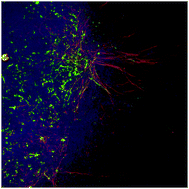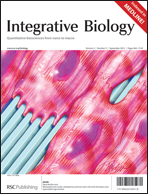Soft microenvironments promote the early neurogenic differentiation but not self-renewal of human pluripotent stem cells†
Abstract
Human pluripotent stem cells (hPSCs) are of great interest in biology and medicine due to their ability to self-renew and differentiate into any adult or fetal cell type. Important efforts have identified biochemical factors, signaling pathways, and transcriptional networks that regulate hPSC biology. However, recent work investigating the effect of biophysical cues on mammalian cells and adult stem cells suggests that the mechanical properties of the microenvironment, such as stiffness, may also regulate hPSC behavior. While several studies have explored this mechanoregulation in mouse embryonic stem cells (mESCs), it has been challenging to extrapolate these findings and thereby explore their biomedical implications in hPSCs. For example, it remains unclear whether hPSCs can be driven down a given tissue lineage by providing tissue-mimetic stiffness cues. Here we address this open question by investigating the regulation of hPSC neurogenesis by microenvironmental stiffness. We find that increasing extracellular matrix (ECM) stiffness in vitro increases hPSC cell and colony spread area but does not alter self-renewal, in contrast to past studies with mESCs. However, softer ECMs with stiffnesses similar to that of neural tissue promote the generation of early neural ectoderm. This mechanosensitive increase in neural ectoderm requires only a short 5-day soft stiffness “pulse”, which translates into downstream increases in both total neurons as well as therapeutically relevant dopaminergic neurons. These findings further highlight important differences between mESCs and hPSCs and have implications for both the design of future biomaterials as well as our understanding of early embryonic development.


 Please wait while we load your content...
Please wait while we load your content...